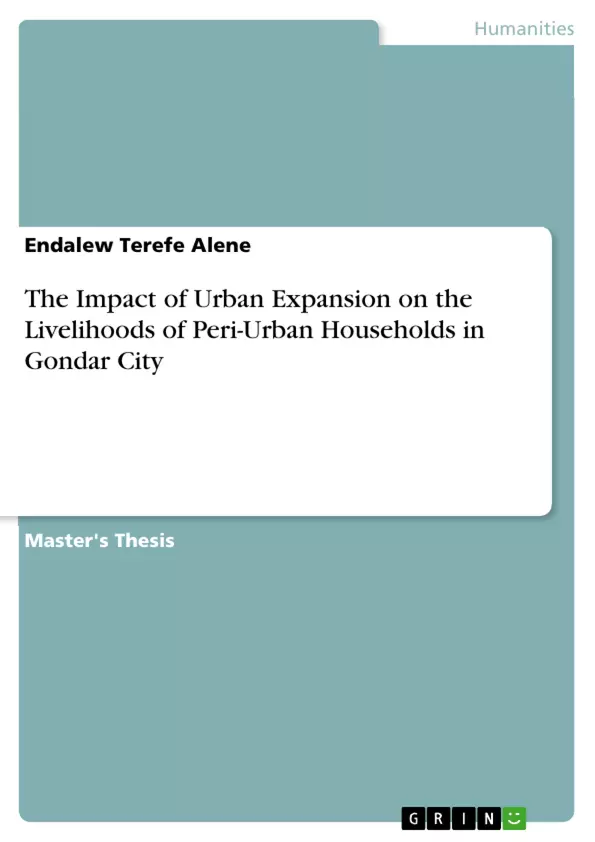Recently, Gondar city was grown into a metropolitan city status. This means that, Gondar city is among the Ethiopian urban settings experiencing unprecedented rate of urbanization through expansion expanding in different directions into the surrounding rural areas with fast physical and population growth.
Therefore, the city administration of Gondar has undergone a horizontal expansion pattern. However, no study has been conducted to investigate the impacts of urban expansion on the livelihoods of peri-urban households in Gondar City Administration. This study, therefore, aims to investigate the effects of the expansion program on the livelihoods of the affecting farming households in Gondar city. The study employed household survey, focused group discussion, observation and an in-depth interview with key informants to assess the situation.
The findings were analyzed using both quantitative and qualitative research methods. The results of the study revealed that, the expansion program was not participatory and the compensation payment implemented for the affected households was not fair and equal in relation with the calculation of their possessed assets.
Inhaltsverzeichnis (Table of Contents)
- CHAPTER ONE
- 1.INTRODUCTION
- 1.1. Background of the study
- 1.2. Statement of the Problem
- 1.3. Research objectives
- 1.4. Research Question
- 1.4.1. General Question
- 1.5. Significance of the Study
- 1.6. Scope of the Study
- 1.7. Description of the Study Area
- 1.8 Limitation of the Study
- CHAPTER TWO
- 2.LITERATURE REVIEW
- 2.1. Introduction
- 2.1. Nature of Urban Expansion
- 2.2. Resettlement and Its Effect on Livelihoods of Resettles
- 2.2.1. Emperical Studies on Resettlement Impact
- 2.3. Risks Associated With Displacement
- 2.4. Cause and Consequence of Urban Expansion
- 2.4.1 Causes of Urban Expansion
- 2.4.2. Consequences of Urban Expansion
- 2.4.2.1. Social Consequence of Urban Expansion
- 2.4.2.2. Environmental Consequence of Urban Expansion
- 2.4.2.3. Economic Consequence of Urban Expansion
- 2.5. Sustainable Livelihood Approach and Livelihood Strategies in Peri-Urban Area
- 2.5.1. Sustainable Livelihood Approach
- 2.5.2. Livelihood Strategies of Peri-Urban Area
- 2.6. Conceptual Framework
- CHAPTER THREE
- 3.RESEARCH METHDOLOGY
- 3.1. Introduction
- 3.2. Research Strategy and Type
- 3.3. Research Approach
- 3.4. Methods of Data Collection
- 3.5. Sample Design
- 3.5.1. Population or Universe
- 3.5.2. Sampling Frame
- 3.5.3. Sampling Unit
- 3.5.4. Sampling Techniques
- 3.5.5. Sample Size
- 3.6. Source of Data
- 3.6.1. Primary Data
- 3.6.2. Secondary Data
- 3.7. Data Analysis and Interpretation
- 3.8. Operationalization of Variables
- 3.9. Validity and Reliability
- 3.10. Ethical Consideration
- CHAPTER FOUR
- 4.DATA ANALYSIS AND PRESENTATION
- 4.1. Introduction
Zielsetzung und Themenschwerpunkte (Objectives and Key Themes)
This study aims to investigate the impact of urban expansion on the livelihoods of peri-urban households in Gondar City, Northwest Ethiopia. The study seeks to analyze the effects of the expansion program on farming households and their livelihood assets, including land holding size, common properties, and livestock. It will explore the program's positive and negative impacts, examining the coping mechanisms and strategies employed by the affected households.
- The impact of urban expansion on the livelihoods of peri-urban households in Gondar City.
- The effects of the expansion program on the livelihood assets of affected farming households.
- The coping mechanisms and strategies employed by the households to mitigate the negative impacts of the expansion.
- The role of government initiatives in supporting and rehabilitating affected households.
- Recommendations for future urban expansion programs to ensure community participation and create alternative livelihoods.
Zusammenfassung der Kapitel (Chapter Summaries)
Chapter One provides an introduction to the study, outlining the background, problem statement, research objectives, questions, significance, scope, study area, and limitations.
Chapter Two delves into a comprehensive literature review on the topic of urban expansion, resettlement, and its effects on livelihoods. It explores the nature of urban expansion, the risks associated with displacement, the causes and consequences of expansion, and the sustainable livelihood approach applied to peri-urban areas.
Chapter Three presents the research methodology employed in the study, detailing the research strategy, type, approach, data collection methods, sample design, data sources, analysis techniques, operationalization of variables, and ethical considerations.
Chapter Four focuses on the analysis and presentation of the collected data, highlighting the findings and insights gained from the study.
Schlüsselwörter (Keywords)
The study focuses on urban expansion, peri-urban households, livelihoods, resettlement, Gondar City, Ethiopia, livelihood assets, coping mechanisms, sustainable livelihoods, and participatory urban planning.
- Quote paper
- Endalew Terefe Alene (Author), 2013, The Impact of Urban Expansion on the Livelihoods of Peri-Urban Households in Gondar City, Munich, GRIN Verlag, https://www.grin.com/document/1334280



